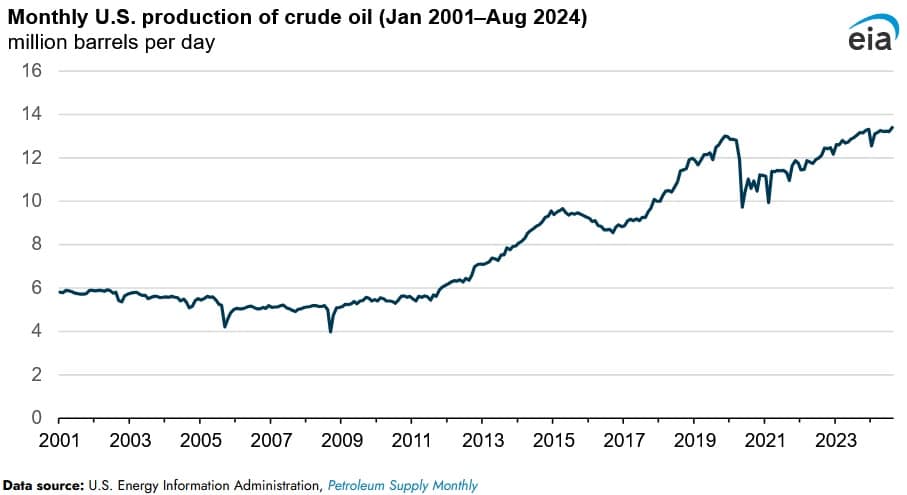U.S. Crude Oil Production Sets a Record High During August 2024: EIA

Average U.S. crude oil production hit a record high of 13.4 million barrels per day (b/d) during August 2024, according to a Nov. 26 report from the U.S. Energy Information Administration. U.S. crude oil production during August 2024 surpassed production during December 2023, when the previous monthly record of 13.3 million b/d was achieved.
The increase in crude oil production can largely be attributed to enhanced efficiency of new wells. Improvements in horizontal drilling and hydraulic fracturing technologies have enhanced well yield, allowing producers to extract higher volumes of crude oil from new wells, while at the same time continuing output from legacy wells. Historically, the number of new wells coming online was a key determinant of whether crude oil production increases or decreases, but now well efficiency is also a key component.
Production has increased despite a decline in the number of active rigs since 2014. Historically, the number of active oil rigs were a key determinant of crude oil. However, more recently U.S. crude oil output has risen due to technological improvements and efficiency advantages. The number of new wells coming online has fluctuated on a yearly basis. The number of new wells reached a new high at 13,745 in 2014 before falling to 7,147 in 2020 due to the adverse economic effect of the COVID-19 pandemic. Since 2020, the amount of new crude oil wells has risen yearly, although at a slower rate.
During the first eight months of the year, average U.S. crude oil production fell below the 13 million b/d threshold on one occasion, during January. The agency forecast average U.S. crude oil production to be 13.2 million/d for the whole of 2024, up 0.3 million b/d compared to the yearly average of 2023. Moreover, the agency forecast average U.S. crude oil production to be 13.5 million b/d during 2025.
The U.S. has been the world’s largest crude oil producer since 2018. U.S. crude oil production, particularly from light sweet crude oil grades, has increased since 2011. Much of the recent growth has occurred in areas such as the Permian region in western Texas and eastern New Mexico, the Federal Offshore Gulf of Mexico, and the Bakken region in North Dakota and Montana.
EnerKnol Pulses like this one are powered by the EnerKnol Platform—the first comprehensive database for real-time energy policy tracking. Sign up for a free trial below for access to key regulatory data and deep industry insights across the energy spectrum.
ACCESS FREE TRIAL


